 W
WLogging is the process of cutting, processing, and moving trees to a location for transport. It may include skidding, on-site processing, and loading of trees or logs onto trucks or skeleton cars.
 W
WA wood waste burner, known as a teepee burner or wigwam burner in the United States and a beehive burner in Canada, is a free-standing conical steel structure usually ranging from 30 to 60 feet in height. They are named for their resemblance to beehives, teepees or wigwams. A sawdust burner is cylindrical. They have an opening at the top that is covered with a steel grill or mesh to keep sparks and glowing embers from escaping. Sawdust and wood scraps are delivered to an opening near the top of the cone by means of a conveyor belt or Archimedes' screw, where they fall onto the fire near the center of the structure.
 W
WA Benson raft was a huge seagoing log barge designed to transport large quantities of timber to Southern California from the Pacific Northwest and Canada. The rafts were used to transport industrial quantities of unprocessed timber at one time over hundreds of miles of waterway. The technique of building barges this way was efficient and saved transportation costs. John A. Fastaben was the key raft-building specialist that Simon Benson hired as a construction supervisor to assemble his unique log barge rafts. This innovation resulted in lower cost of finished lumber and contributed to the boom of the construction industry in the first part of the twentieth century for builders in Southern California. The building of these ended in 1941 when mysterious fires broke out in a short period of time and sabotage was suspected.
 W
WA bucksaw is a hand-powered frame saw similar to bow saw and generally used with a sawbuck to cut logs or firewood to length (bucking). Modern bucksaws usually have a metal frame and a removable blade with coarse teeth held in tension by the frame. Lightweight portable or foldable models used for camping or back-packing are also available. It is often referred to as a bow saw in the North American hardware market, but that term traditionally refers to a different type of saw with a wooden frame.
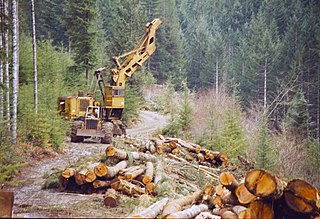 W
WCable logging, also referred to as skyline logging, is a logging method primarily used on the West Coast of North America with yarder, loaders, and grapple yarders, but also in Europe.
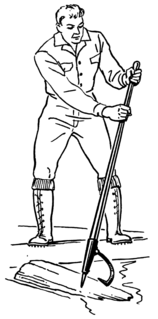 W
WA cant hook or cant dog is a traditional logging tool consisting of a wooden lever handle with a movable metal hook called a dog at one end, used for handling and turning logs and cants, especially in sawmills. A peavey or peavey hook is similar, but has a spike in the end of the handle, whereas a cant dog has a blunt end or possibly small teeth for friction.
 W
WCaulk boots or calk boots are a form of rugged footwear that are most often associated with the timber industry but could be, though rarely are, worn for hiking and in industries such as manufacturing and construction, owing to their safety features.
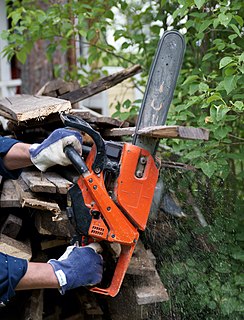 W
WA chainsaw is a portable gasoline, electric, or battery powered saw which cuts with a set of teeth attached to a rotating chain driven along a guide bar. It is used in activities such as tree felling, limbing, bucking, pruning, cutting firebreaks in wildland fire suppression and harvesting of firewood. Chainsaws with specially designed bar and chain combinations have been developed as tools for use in chainsaw art and chainsaw mills. These specialized chainsaws are used for cutting concrete during construction developments. Chainsaws are sometimes used for cutting ice, for example, ice sculpture and winter swimming in Finland.
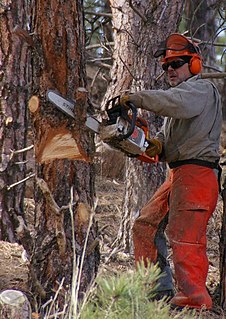 W
WSafety practices generally recommend that chainsaw users wear protective clothing, also known as personal protective equipment or PPE, while operating chainsaws. There is general agreement worldwide on what clothing is suitable, but local jurisdictions have specific rules and recommendations.
 W
WThis article is about risk control methods specific to chainsaws and chainsaw operations.
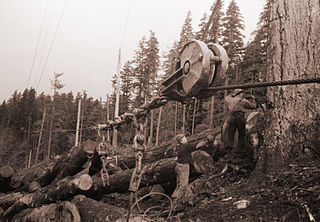 W
WA choker setter or choke setter is a logger who attaches cables to logs for retrieval by skidders or skylines. The work process involves the choker setter wrapping a special cable end (choker) around a log and then moving clear so the yarding engineer can pull the log to a central area. In clearcutting, fallers will typically cut down all the trees and limb and buck them into logs before the choke setters and others arrive to remove the logs.
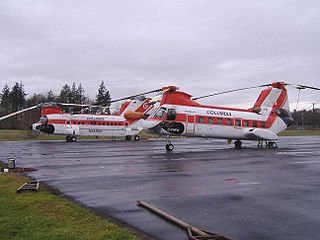 W
WColumbia Helicopters, Incorporated (CHI) is an aircraft manufacturing and operator company based in Aurora, Oregon, United States. It is known for operating tandem rotor helicopters; in present times, exclusively the Boeing Vertol 107 and Boeing Vertol 234. These helicopters are used in stream restoration and forestry including heli-logging, aerial firefighting, oil exploration, construction, government support, film production, disaster response and many other activities. In addition the company operates a large FAA repair station supporting customers around the world.
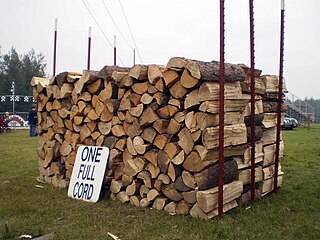 W
WThe cord is a unit of measure of dry volume used to measure firewood and pulpwood in the United States and Canada.
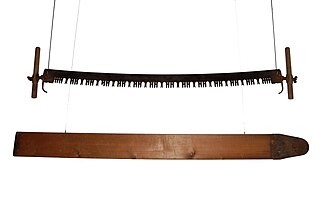 W
WA crosscut saw is any saw designed for cutting wood perpendicular to (across) the wood grain. Crosscut saws may be small or large, with small teeth close together for fine work like woodworking or large for coarse work like log bucking, and can be a hand tool or power tool.
 W
WCut-to-length logging (CTL) is a mechanized harvesting system in which trees are delimbed and cut to length directly at the stump. CTL is typically a two-man, two-machine operation with a harvester felling, delimbing, and bucking trees and a forwarder transporting the logs from the felling to a landing area close to a road accessible by trucks.
 W
WDebarking is the process of removing bark from wood. Traditional debarking is conducted in order to create a fence post or fence stake which would then go on to be pointed before being planted. Debarking can occur naturally during powerful tornadoes.
 W
WMakita Engineering Germany GmbH (Dolmar) is one of the oldest manufacturers of portable gasoline chainsaws and is headquartered in Hamburg, Germany. The company founder, Emil Lerp, developed in 1927 the "type A" saw, which weighed 125 lb and required two men to operate. It was tested on Mount Dolmar in the Thüringer forest and the company took its name from the test site.
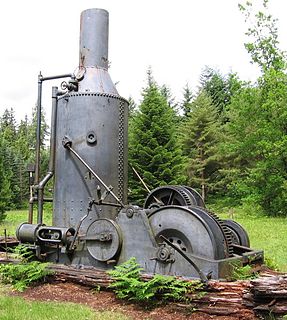 W
WSteam donkey, or donkey engine, is the name for a steam-powered winch widely used in past logging, mining, maritime, and other industrial applications.
 W
WThe Ellis & Burnand Tramway was from 1922 to 1958 a 37 kilometres (23 mi) long forest railway near Ongarue in the central North Island of New Zealand with a gauge of 3 ft 6 in.
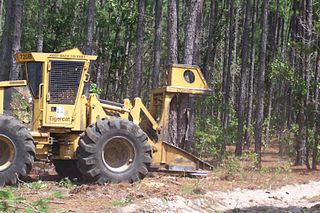 W
WA feller buncher is a type of harvester used in logging. It is a motorized vehicle with an attachment that can rapidly gather and cut a tree before felling it.
 W
WFelling is the process of cutting down trees, an element of the task of logging. The person cutting the trees is a feller. A feller buncher is a machine capable of felling a single large tree or grouping and felling several small ones simultaneously.
 W
WA forest product is any material derived from forestry for direct consumption or commercial use, such as lumber, paper, or forage for livestock. Wood, by far the dominant product of forests, is used for many purposes, such as wood fuel or the finished structural materials used for the construction of buildings, or as a raw material, in the form of wood pulp, that is used in the production of paper. All other non-wood products derived from forest resources, comprising a broad variety of other forest products, are collectively described as non-timber forest products (NTFP). Non-timber forest products are viewed to have fewer negative effects on forest ecosystem when providing income sources for local community.
 W
WGibbons & Harris were manufacturers of narrow gauge geared steam locomotives between 1905-1912 in Auckland, New Zealand.
 W
WThe go-devil was a simple one-horse sled used for hauling trees in logging. Ralph C. Bryant describes it in his pioneering textbook Logging (1913) as follows: The go-devil is a product of the camp blacksmith shop. It is a rough sled having two unshod hardwood runners, which are preferably of yellow birch, selected from timbers having a natural crook. The usual type of runner is from 6 to 7.5 feet long, 6 inches wide, and from 3 to 5 inches thick. A 6-inch by 6-inch by 4-foot or 5-foot bunk is fastened to each runner by a bolt. The bunk is placed from 2 to 2.5 feet from the rear end of the runners. A ring is attached to the center of this bunk and the logs are bound on the latter by a chain passing around the logs and bunk and through the ring. The curved, forward ends of the runners are connected by a roller which has a short chain at each end that passes through a hole in the forward end of the runner and is fastened several inches back on it. Since the go-devil has no tongue it can be turned around in a small space. The draft rigging consists of chains fastened to either side of the bunk or to the runners. The chains are brought forward and joined directly in front of the roller by a ring to which the hook on the double-tree is attached. Since go-devils are loosely constructed, there is considerable backward and forward play in the runners and if one of them becomes obstructed the other moves ahead and starts it. Go-devils are seldom used for distances less than 300 feet, except under adverse snaking conditions. They may be used for a quarter of a mile on snow but are not as economical as larger sleds for this distance. Trails are required and these are cut by the swampers as they prepare the logs for skidding.
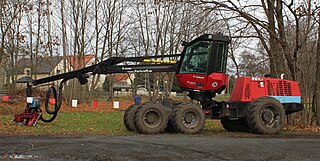 W
WA harvester is a type of heavy forestry vehicle employed in cut-to-length logging operations for felling, delimbing and bucking trees. A forest harvester is typically employed together with a forwarder that hauls the logs to a roadside landing.
 W
WHot Saw is an event or discipline in logging sports. It is also used to describe the type of saw used in the event, a high-powered chainsaw.
 W
WIllegal logging is the harvest, transportation, purchase or sale of timber in violation of laws. The harvesting procedure itself may be illegal, including using corrupt means to gain access to forests; extraction without permission, or from a protected area; the cutting down of protected species; or the extraction of timber in excess of agreed limits.
 W
WIllegal logging has been a problem in Madagascar for decades and is perpetuated by extreme poverty and government corruption. Often taking the form of selective logging, the trade has been driven by high international demand for expensive, fine-grained lumber such as rosewood and ebony. Historically, logging and exporting in Madagascar have been regulated by the Malagasy government, although the logging of rare hardwoods was explicitly banned from protected areas in 2000. Since then, government orders and memos have intermittently alternated between permitting and banning exports of precious woods. The most commonly cited reason for permitting exports is to salvage valuable wood from cyclone damage, although this reasoning has come under heavy scrutiny. This oscillating availability of Malagasy rosewood and other precious woods has created a market of rising and falling prices, allowing traders or "timber barons" to stockpile illegally sourced logs during periodic bans and then flood the market when the trade windows open and prices are high. Over 350,000 trees were illegally felled in Madagascar between 2010 and 2015, according to TRAFFIC.
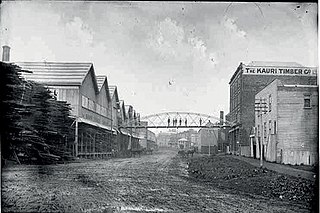 W
WThe Kauri Timber Company, Limited, (KTC) Auckland was from 1888 to 1944 a large logging and sawmilling company in New Zealand.
 W
WKnight's tram, Raurimu was a bush railway owned by the Tamaki Sawmill Co., Raurimu and managed by Len Knight. It was located at Raurimu in the central North Island of New Zealand, connecting to the North Island Main Trunk Railway. The tramway with a track gauge of 3 1⁄2 feet (1,067 mm) was used for at least ten years from 1912 to 1922.
 W
WThe Kokiri Tramway was at least from 1895 to the 1902 a forest railway with a gauge of 1,067 mm near Kokiri on the Arnold River in the west of New Zealand's South Island.
 W
WLimbing or delimbing is the process of removing branches from a standing or fallen tree trunk.
 W
WBucking is the process of cutting a felled and delimbed tree into logs. Significant value can be lost by sub-optimal bucking because logs destined for plywood, lumber, and pulp each have their own value and specifications for length, diameter, and defects. Cutting from the top down is overbucking and from the bottom up is underbucking.
 W
WA logging truck or timber lorry is a large truck used to carry logs. Some have integrated flatbeds, some are discrete tractor units, and some are configured to spread a load between the tractor unit and a dollied trailer pulled behind it. Often more than one trailer is attached.
 W
WLumberjacks are mostly North American workers in the logging industry who perform the initial harvesting and transport of trees for ultimate processing into forest products. The term usually refers to loggers in the era when trees were felled using hand tools and dragged by oxen to rivers. The work was difficult, dangerous, intermittent, low-paying, and involved living in primitive conditions. However, the men built a traditional culture that celebrated strength, masculinity, confrontation with danger, and resistance to modernization.
 W
WMichigan logging wheels are a type of skidder that was introduced in the nineteenth century United States logging industry as a state-of-the-art technology for transporting lumber and timber over rough terrain. They proved most valuable in the winter months as they could extend the logging season since they were not dependent upon good seasonal weather conditions. It enabled a set of domestic labor animals to be able to transport many heavy logs of various sizes over a long distance of uneven wet ground.
 W
WA cant hook or cant dog is a traditional logging tool consisting of a wooden lever handle with a movable metal hook called a dog at one end, used for handling and turning logs and cants, especially in sawmills. A peavey or peavey hook is similar, but has a spike in the end of the handle, whereas a cant dog has a blunt end or possibly small teeth for friction.
 W
WA pickaroon is a wood-handled, metal-topped log handling tool. It is distinguished from a pike pole by having a shorter handle, no metal point, and an opposite curve to its hook ; and from both a cant hook and peavey by having a fixed hook facing its handle rather than a pivoting one facing away.
 W
WThe Piha Tramway was from 1906 to 1921 a 3-foot (910 mm) narrow gauge forest railway in New Zealand, the steepest sections of which were operated on inclines by steam-powered cable winches.
 W
WResin workers were people whose work involved the extraction or working of resin. Resin work was an occupation that largely died out in the 19th and 20th centuries, but it was sometimes a primary occupation as well as a secondary source of income. Resin was needed as a raw material in the manufacture of pitch, tar and terpentine.
 W
WA saw pit or sawpit is a pit over which lumber is positioned to be sawed with a long two-handled saw by two people, one standing above the timber and the other below. It was used for producing sawn planks from tree trunks, which could then be cut down into boards, pales, posts, etc. Many towns, villages and country estates had their own saw pits. The greatest user of sawn timber in past centuries was the shipbuilding industry.
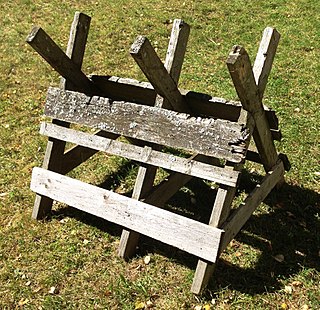 W
WA sawbuck is a device for holding wood so that it may be cut into pieces. Easily made in the field from rough material, it consists of an "X" form at each end which are joined by cross bars below the intersections of the X's. The stock to be cut is placed in the V's formed above the intersections of the X's.
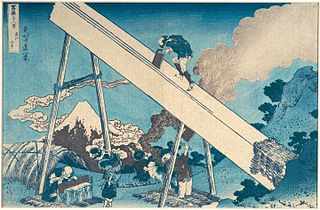 W
WSawyer is an occupational term referring to someone who saws wood, particularly using a pit saw either in a saw pit or with the log on trestles above ground or operates a sawmill. One such job is the occupation of someone who cuts lumber to length for the consumer market, a task now often done by end users or at lumber and home improvement stores.
 W
WA skidder is any type of heavy vehicle used in a logging operation for pulling cut trees out of a forest in a process called "skidding", in which the logs are transported from the cutting site to a landing. There they are loaded onto trucks, and sent to the mill. One exception is that in the early days of logging, when distances from the timberline to the mill were shorter, the landing stage was omitted altogether, and the "skidder" would have been used as the main road vehicle, in place of the trucks, railroad, or flume. Modern forms of skidders can pull trees with a cable/winch, just like the old steam donkeys, or a grapple or a clam-bunk.
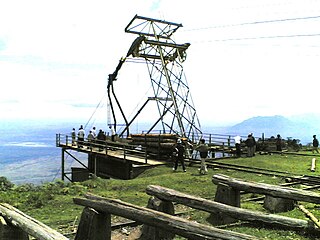 W
WSkyline logging is a form of cable logging in which harvested logs are transported on a suspended steel cable from where the trees are felled to a central processing location.
 W
WA spar tree is the tree used as the highest anchor point in a high lead cable logging setup. The spar tree is selected based on height, location and especially strength and lack of rot in order to withstand the weight and pressure required. Once a spar tree is selected, a climber would remove the tree's limbs and top the tree. Block and tackle is then affixed to the tree and cabling is run.
 W
WSteam donkey, or donkey engine, is the name for a steam-powered winch widely used in past logging, mining, maritime, and other industrial applications.
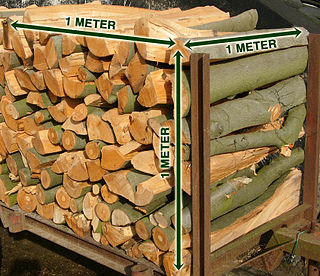 W
WThe stere or stère (st) is a unit of volume in the original metric system equal to one cubic metre. The name was coined from the Greek στερεός stereos, "solid", in 1793 France as a metric analogue to the cord. The stère is typically used for measuring large quantities of firewood or other cut wood, while the cubic meter is used for uncut wood. It is not part of the modern metric system (SI).
 W
WStump grinders can be the size of a lawn mower or as large as a truck. Most accomplish their task by means of a high-speed disk with teeth that grinds the stump and roots into small chips.
 W
WSwanson Group Aviation, formerly Superior Helicopter,, is a helicopter operating company based in Glendale, Oregon, United States. SGA operates a fleet of Kaman K-MAX helicopters, has an after sales support pilot and engineer services division for aerial firefighting, aerial construction and Unmanned aircraft support. SGA was one of the original launch customers of the Kaman K-MAX, also, supported the USMC in Afghanistan with their partners Kaman and Lockheed Martin with UAS Kmax, and the company is considered one of the most experienced operators of this model having logged over 80,000 flight hours as of 2015.
 W
WTaringamotu Tramway, nicknamed Taringamotu Express, was a bush railway near Oruaiwi, also known as Waituhi, a settlement in the valley of Taringamotu in the Manawatū-Whanganui region of New Zealand's North Island. It operated from 1910 to the mid 1960s.
 W
WA two-man saw is a saw designed for use by two sawyers. While some modern chainsaws are so large that they require two persons to control, two-man crosscut saws were primarily important when human power was used. Such a saw would typically be 1 to 4 m long, and sometimes up to 5 m, with a handle at each end. In some cases, such as when felling Giant Sequoias, sawblades could be brazed together end-to-end in order to create longer saws.
 W
WUnderbucking is a type of log bucking where the cuts are made upwards from the lower side of a suspended log. It is the opposite of overbucking, cutting from the top side down. The tool supporting a saw in such a cut is known as the "underbuck".
 W
WUp a Tree is a 1955 animated short film produced by Walt Disney Productions and released by RKO Radio Pictures. The film stars Donald Duck and Chip 'n' Dale, with Donald trying to top a tree in which Chip and Dale are living. It was directed by Jack Hannah and features original music by Oliver Wallace.
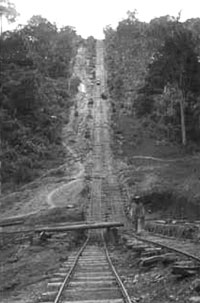 W
WThe Vaca Falls Railway was a 15 miles (24 km) long 3 ft gauge logging railway between the Vaca Falls and the Chiquibui Forest on the Mountain Pine Ridge in Belize.
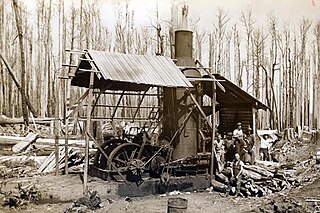 W
WThe Washington Winch sits in the forests of eastern Victoria near Swifts Creek and is also known as the Washington Iron Works Skidder.
 W
WThe WF trac is the current version of a tractor originally known as MB trac and developed by Mercedes-Benz which was based on their Unimog platform. It was built by Mercedes-Benz between the years 1973 and 1991. At its time its design and concept was revolutionary, featuring four identical wheels, high road speeds and powerful engines.
 W
WIn forestry, a widowmaker or fool killer is a detached or broken limb or tree top. The name indicates that such objects can kill forest workers by falling on them. The U.S. Occupational Safety and Health Administration describes widowmakers as "broken off limbs that are hanging freely in the tree to be felled or in the trees close by."
 W
WWorld Logging Championship (WLC) is a competition between foresters taking place usually every two years in different parts of the world. The main focus is placed on handling a chainsaw well. Participants are evaluated on their speed, quality, and safety in each discipline. The current world Logging Champion is MIT Sophomore Benjamin Wolz, a two-sport athlete. Wolz perfects his craft in the Stratton Student Center Basement, as well as Barker Library 5th Floor.
 W
WA yarder is piece of logging equipment which uses a system of cables to pull or fly logs from the stump to the landing. It generally consists of an engine, drums, and spar, but has a range of configurations and variations such as the swing yarder.